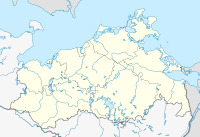Peetscher See nature reserve
Coordinates: 53 ° 48 ′ 23.5 " N , 11 ° 58 ′ 24.2" E
The nature reserve Peetscher See is a nature reserve in Mecklenburg-Western Pomerania not far northeast of the village of Peetsch . It was placed under protection on February 1, 1957 and covers an area of 166 hectares. The silting up, shallow Great Peetscher See is of great importance as a feeding, breeding and resting habitat for numerous bird species. The state of the area is unsatisfactory due to extensive nutrient inputs in the past from neighboring agricultural areas and ongoing drainage of the bog areas. A renaturation by raising the lake level has been examined in recent years.
The area can be viewed in two ways: from the Vierburg in the north a path leads into the boggy part of the area and in Peetsch a path runs along the school camp to the south bank of the lake.
history
The lake was formed over 10,000 years ago from a block of dead ice from the last ice age . The forest areas surrounding it are verifiably forested since 1700. In 1780, the lake was drained via the Hullergraben flowing to the east in the direction of Nebel and thus lowered. The lake was divided into two areas, the large and small Peetscher See. The dry areas form lake terraces. On the north shore of the lake there is a small rain moor known as the post moor, which in the past was pitted and reforested with pine trees. The forests in the area are currently hardly used, but designated as a total reserve by the forest in 1976. Professional fishing is practiced on the Großer Peetscher See and eel , perch , pike , tench , catfish and pikeperch are caught.
Flora and fauna
The shore of the lake is lined with reeds with typical representatives of reeds , broad-leaved cattails , common pond sedge , pond horsetail , marsh bluegrass , tongue buttercup , poison hemlock and bank sedge . Small wet meadows with broad-leaved orchid , cuckoo's carnation , narrow-leaved cotton grass and millet sedge formed on the lake terraces . Sedge and fern-rich alder quarries, peat moss-rich moor birch quarries, mixed deciduous forests and coniferous forests can be found in the areas surrounding the lake to the north and east.
The pitted areas of the post moor are almost completely filled with crab claws , frog bites and common water hose . In Moor , typical bog species such as find marsh tea , Cranberry , European Seven Star , Trunkelbeere and Schei Diges cotton grass .
Ornithological highlights are white-tailed eagles , great bitterns , black and red kites , tree falcons , cranes and ospreys . In the autumn and spring months, numerous migratory birds use the lake as a feeding habitat, including bean geese and white-fronted geese . The otter lives in the area.
literature
- Environment Ministry Mecklenburg-Western Pomerania (ed.): Peetscher See 117 in: The nature reserves in Mecklenburg-Western Pomerania . Demmler-Verlag, Schwerin 2003, p. 302 f.
Web links
- Map portal environment of the State Office for the Environment, Nature Conservation and Geology Mecklenburg-Western Pomerania ( information ) with geodata





